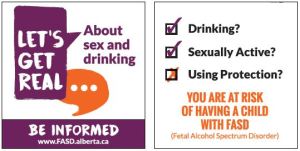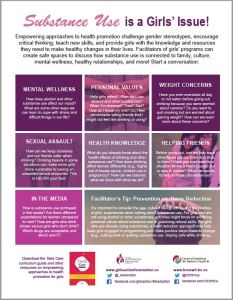 With marketing of alcohol and nicotine delivery products to youth, legalization of cannabis, and the crisis in prescription pain medication use, there are new opportunities to have conversations with youth about substance use and pregnancy, with the aim of reducing the harms and improving their overall health.
With marketing of alcohol and nicotine delivery products to youth, legalization of cannabis, and the crisis in prescription pain medication use, there are new opportunities to have conversations with youth about substance use and pregnancy, with the aim of reducing the harms and improving their overall health.
What do we know about youth understanding of substance use and pregnancy?
Existing research and data on youth behaviour provide a window.
One U.S. study showed a relationship between pregnancy and prior substance use among adolescents, and among younger adolescents in particular.
- 59% of pregnant teens and 35% of nonpregnant teens reported having used substances in the previous 12 months.
- Some substance use continued in pregnancy particularly among younger pregnant adolescents ages 12-14. (1)
The McCreary Centre Society conducts an adolescent health survey in BC every 5 years. The 2018 evaluation is underway, but findings from 2013 indicated a number of factors related to youth substance use and pregnancy.
Those at higher risk for harmful alcohol use include:
- Youth in rural areas
- Youth who were born in Canada
- Youth who were employed
- Youth living in poverty
- Youth experiencing abuse or violence
- Sexual minority youth
- Peer relationships have risks in terms of starting drinking earlier and binge drinking particularly when friend groups are large.
Those at greater risk of being involved in a pregnancy include:
- Youth who first had sex before their 14th birthday
- Youth in rural areas
- Youth who had been in government care. Among these youth, girls were more likely than boys to be have been involved in a pregnancy
- Youth who had been physically abused
- Youth who had been sexually abused. Among these youth, males who were more likely to have been involved in a pregnancy.
The Ontario Student Drug Use and Health Survey (OSDUHS) from 2017 shows that:
- 17% of youth have participated in binge drinking and 16% cannot remember what happened during that time
- Boys are more likely to use e-cigarettes and all forms of tobacco, over-the-counter cold/cough medications, energy drinks, cannabis, and psychedelics
- Girls are more likely to use prescription opioids for pain relief and tranquilizers medically
IMPART info sheet on “Youth, Gender and Substance Use” recaps how the harms of early substance use are gender-specific.
How do we approach building awareness and prevention?
Opening “Doorways to Conversation” about substance use and pregnancy allows for brief interventions and support for youth as well as women and girls. Many providers think that they need to have appropriately tested screening tools along with the knowledge, skills and confidence to conduct them. As one United Nations study found, less than 30% of health providers routinely screened youth for substance use for these reasons.(2)
Trauma-informed, culturally relevant, and gender-specific relational approaches build trusting relationships that can support youth who may be dealing with more complex issues like violence and abuse, gender identity, or the foster care system.
Promising Approaches for Reaching Youth on Substance Use and Pregnancy
Here are some current promising approaches to improving youth understanding of substance use and pregnancy in Canada.
 |
Projects like “Let’s Get Real About Drinking Alcohol” are trainings for youth focusing on the interconnection of substance use, safe sex, birth control, and drinking during pregnancy. You can view a webcast about the project here. |
 |
This handout offers conversation starters on substance use for group facilitators. Girls Action Foundation “Take Care”program provides a curriculum and resources for facilitators of girls’ groups to promote critical thinking about healthy living including substance use and sexuality. |
 |
Canadian Centre on Substance Use and Addiction (CCSA) has created a low-risk drinking guide for youth. |
Online sexual health resources for youth:
 |
 |
| Teen Health Source | Native Youth Sexual Health Network |
- Christopher P. Salas-Wright, Michael G. Vaughn, Jenny Ugalde, Jelena Todic. Substance Use and Teen Pregnancy in the United States: Evidence from the NSDUH 2002–2012. Addictive Behaviors, 2015; DOI: 10.1016/j.addbeh.2015.01.039
- Chakravarthy, B., Shah, S., & Lotfipour, S. (2013). Adolescent drug abuse – Awareness & prevention. The Indian Journal of Medical Research, 137(6), 1021–1023.

